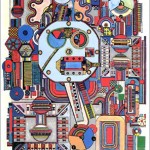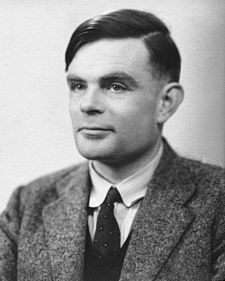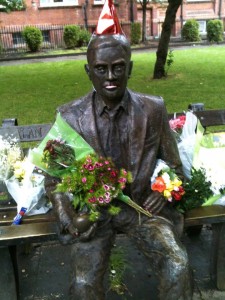Next free walking tour: Sunday 11 February 2024, 12 noon.
Meeting Place: Manchester Museum entrance, Oxford Road, Chorlton-on-Medlock.
Booking: Please press here to book for free with Eventbrite.
Alan Turing has gone down in history as the man who didn’t invent the computer! He should have, in the 1940s, but didn’t have the spare parts to do so. When he discovered to his chagrin that mathematicians at Manchester University had beaten him to it in the summer of 1948 into building the world’s first programmable computer he contacted the department and had little difficulty convincing them he should be hired; his reputation went before him.
We now know, though it was a secret at the time, that Alan Turing had had an excellent war, heavily involved in cracking the supposedly uncrackable codes that the Nazis had encrypted into their Enigma machine. Turing had been a maths prodigy as a boy. At the age of 14 his first day at Sherborne school coincided with the 1926 General Strike. So determined was he to attend school, he biked it 60 miles to the school, stopping overnight at an inn. At Sherborne he developed an interest in the latest mathematical philosophies, in particular Bertrand Russell’s paradox: “the set of all tea cups is not a member of itself, but the set of all non-tea cups is”, its beautiful and simple resonance so influential in the development of logic as a science.
 At Cambridge University Turing developed the idea of a thinking electronic machine but lacked the parts to build one. Manchester had succeeded (find out more on our Oxford Road/University/Science walks) and Turing helped extend the department’s knowledge of primitive computer technology, working in a small brick office on Coupland Street.
At Cambridge University Turing developed the idea of a thinking electronic machine but lacked the parts to build one. Manchester had succeeded (find out more on our Oxford Road/University/Science walks) and Turing helped extend the department’s knowledge of primitive computer technology, working in a small brick office on Coupland Street.
It all went wrong for Turing in the 1950s after he picked up a boy at the Regal Cinema on Oxford Street (now the Dancehouse Theatre) and took him home. The boy allegedly tried to blackmail Turing, and the mathematician went to the police. When they discovered that there had been a (then illegal) homosexual relationship between the two men they turned the tables on Turing and prosecuted him for gross indecency. His conviction led to the removal of his security clearance at a time of public anxiety about spies and homosexual entrapment by Soviet agents. He was forced to take hormones to “cure” him of his sexual leanings which made him grow breasts, and on 8 June 1954 Turing’s cleaner found him dead. The cause was established as cyanide poisoning.
Did Alan Turing commit suicide, depressed about his career and life being in ruins, or was his death an accident brought on by failing to take care following one of his numerous chemical experiments? A further complication to the drama suggests that Turing was re-creating a scene from his favourite film, Snow White, and that he deliberately executed an ambiguous death to save his mother from too much embarrassment.
Alan Turing was cremated at Woking; his life-size statue occupies pride of place in Sackville Park, where we end the tour.
*****
• Many thanks to Jury’s Inn, Manchester, for supporting our tour. Here is their excellent tribute.
Alan Turing of Manchester, by Jurys Inn Manchester Hotel



